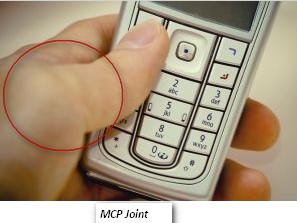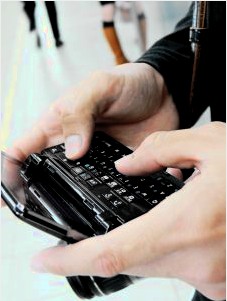Texting Ergonomics

Quick, repetitive movements over an extended period of time have been closely linked to tendon and tendon sheath disorders, in particular tendinitis and tenosynovitis. the thumb is not immune to these conditions. In fact, due to its high mobility it may be even more easily compromised than other body parts.
PubMed literature search of scholarly articles resulted in 42 articles. All but eight were discarded as they did not directly relate to texting. Remaining were one from Malaysia, One from South Africa, one from Finland and two from Sweden, one from Pennsylvania, one from Taiwan, one from Poland, and two from Canada. hands very difficult unless a shoulders forward and hunched posture is used. This overall posture affects every down–stream structure.
hands very difficult unless a shoulders forward and hunched posture is used. This overall posture affects every down–stream structure.
Berolo, Wells and Amick from Canada found a strong relationship between the amount of time people spent using their mobile device and right shoulder and neck pain (95% confidence level). Interestingly, base of the right thumb pain was just as strongly related to internet browsing. Perhaps the thumb is not where we should be looking for mobile device effects.
On the other hand, Ming, Pietikainen and Hänninen at the University of Kuopio in Finland found texting as the probable cause of subluxation of the right thumb and arthritis in the Carpal–Metacarpal Joint(CMC — Wrist to Thumb joint). But this is a single case.
In Taiwan, 12 college students were studied for muscle response in shoulder and thumb, Blood volume pulse from the middle finger, temperature of the middle finger, respiration while texting, and when not texting. The students were very familiar with texting. The results showed increases in all measures except respiration when the students were texting. They held their breath while texting. Skin response indicated excitement when they received text messages. Eighty-three percent of the students reported hand and neck pain while they were texting.
Now we have two articles supporting the postural set in neck and shoulders potential problems.
Ashurst, Turco and Lied from Pennsylvia looked at De Quervains tenosynovitis and texting. The most common cause of De Quervains is overuse of the thumb. This is a case study bilateral DeQuervains in a rural woman who did lots of texting. Limiting her texting and following normal conservative treatment for De Quervains resulted in a complete recovery.
Pennsylvia looked at De Quervains tenosynovitis and texting. The most common cause of De Quervains is overuse of the thumb. This is a case study bilateral DeQuervains in a rural woman who did lots of texting. Limiting her texting and following normal conservative treatment for De Quervains resulted in a complete recovery.
Gustafsson, Johnson, and Hagberg from the University of Gothenburg in Sweden found that the quicker and more constant the thumb movement, the more likely a person is to experience pain and to develop stressors that may lead to injury.
Professionals across the spectrum of health care generally recognize that texting is probably a significant cause for the recent increase in De Quervains Tenosynovitis. The Canadian Occupational Health and Safety Association, the American Society of Hand Therapists and others all agree that Texting is problematic.
Who am I to argue?
It seems that the ergonomics risks in texting are the same as Ergonomic risks with any keyboard activity. Amount of repetition, Speed, Force and Posture are the main issues.
PubMed literature search of scholarly articles resulted in 42 articles. All but eight were discarded as they did not directly relate to texting. Remaining were one from Malaysia, One from South Africa, one from Finland and two from Sweden, one from Pennsylvania, one from Taiwan, one from Poland, and two from Canada.
Posture or Repetition
Several non–juried articles indicated that as much trouble as the repetitive, quick motions were, the general posture people used when texting was even more of a problem. The small size of the devices used for texting makes using both hands very difficult unless a shoulders forward and hunched posture is used. This overall posture affects every down–stream structure.
hands very difficult unless a shoulders forward and hunched posture is used. This overall posture affects every down–stream structure.Berolo, Wells and Amick from Canada found a strong relationship between the amount of time people spent using their mobile device and right shoulder and neck pain (95% confidence level). Interestingly, base of the right thumb pain was just as strongly related to internet browsing. Perhaps the thumb is not where we should be looking for mobile device effects.
On the other hand, Ming, Pietikainen and Hänninen at the University of Kuopio in Finland found texting as the probable cause of subluxation of the right thumb and arthritis in the Carpal–Metacarpal Joint(CMC — Wrist to Thumb joint). But this is a single case.
In Taiwan, 12 college students were studied for muscle response in shoulder and thumb, Blood volume pulse from the middle finger, temperature of the middle finger, respiration while texting, and when not texting. The students were very familiar with texting. The results showed increases in all measures except respiration when the students were texting. They held their breath while texting. Skin response indicated excitement when they received text messages. Eighty-three percent of the students reported hand and neck pain while they were texting.
Now we have two articles supporting the postural set in neck and shoulders potential problems.
Ashurst, Turco and Lied from
 Pennsylvia looked at De Quervains tenosynovitis and texting. The most common cause of De Quervains is overuse of the thumb. This is a case study bilateral DeQuervains in a rural woman who did lots of texting. Limiting her texting and following normal conservative treatment for De Quervains resulted in a complete recovery.
Pennsylvia looked at De Quervains tenosynovitis and texting. The most common cause of De Quervains is overuse of the thumb. This is a case study bilateral DeQuervains in a rural woman who did lots of texting. Limiting her texting and following normal conservative treatment for De Quervains resulted in a complete recovery.Gustafsson, Johnson, and Hagberg from the University of Gothenburg in Sweden found that the quicker and more constant the thumb movement, the more likely a person is to experience pain and to develop stressors that may lead to injury.
Professionals across the spectrum of health care generally recognize that texting is probably a significant cause for the recent increase in De Quervains Tenosynovitis. The Canadian Occupational Health and Safety Association, the American Society of Hand Therapists and others all agree that Texting is problematic.
Who am I to argue?
It seems that the ergonomics risks in texting are the same as Ergonomic risks with any keyboard activity. Amount of repetition, Speed, Force and Posture are the main issues.
Here are some tips for good thumb health
- Try to vary your posture. Sit back, sit forward, even slouch for a few minutes. Variety will assist in your protection.
- Take frequent breaks
- Hold the device with your wrists in a neutral posture.
- Use the chair backrest most of the time.
- Support the weight of your arms by resting them on a table when possible. This keeps the device fairly close to your eyes and reduces neck flexion.
- Stretch your arms out and open your chest occasionally.
- Use both thumbs. This lessens the probability of injury.
- Stand up and stretch
- Don't try to do a long message all at once. Give your thumbs a break.
- Don't type too fast. That's been shown to increase liklihood of injury.
- Use keyboard shortcuts and abbreviations. Teach them to others so they can understand you.
- As much as possible, bring the device to your eyes instead of your eyes to the device. This will help in maintaining good posture.
- Stop frequently to slowly and gently stretch your hands and fingers. NEVER stretch into pain.
- Be aware of your body. Be on the alert for discomfort, or a feeling of poor circulation in the arms and hands. If this occurs, stop texting and stretch
- If you begin to feel lasting or recurring pain, see your Doctor.
This site needs an editor - click to learn more!

Related Articles
Editor's Picks Articles
Top Ten Articles
Previous Features
Site Map
Content copyright © 2023 by virginia hixson. All rights reserved.
This content was written by virginia hixson. If you wish to use this content in any manner, you need written permission. Contact
BellaOnline Administration
for details.


